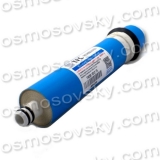
In modern reverse osmosis filters are used roll (spiral wound) flat (thin film) made of polyamide (PA, Nylon) membrane. Purification of water occurs on the surface of a reverse osmosis membrane; through its top layer portion of the system into the drinking water molecules penetrate only.
The basis of any filter is a reverse osmosis semipermeable membrane through which pressurized water molecules tested, as dissolved impurities (organic salts, slurry, etc.) remain on the surface and removed from the membrane coming back portions of water.
Such semipermeable membranes are widely distributed in nature; Similar processes occur in the cells of living organisms - from plants to higher mammals.
The first mention of osmosis processes belong to the middle of the eighteenth century; the first working samples of fine-mesh coating capable obessalivat water, were obtained in the fifties of the last century.
For the manufacture of the filtering film most commercial reverse osmosis membranes are used cellulose acetate, and an aromatic polyamide.
The idea of the membrane as a monolithic film with a fine mesh is not quite true; filtering surface consists of a fibrous material (water molecules seep between closely spaced fibers), which can absorb water by acetyl or like group forming filtration surface. Thick layer of active surface area of about 0.25 microns; it is applied to a thicker layer of porous material structure.
When you move water through the reverse osmosis membrane is a series of processes: diffusion transfer operates selective and capillary permeability.
Most membranes manufactured as an envelope wound on a hollow shaft with perforations; This configuration produces a large filtration area in a compact footprint.
And cellulose acetate membrane
Cellulose acetate provides better performance, respectively, requires less membrane area. It is also resistant to low concentrations of free chlorine and consequently the cellulose acetate membranes can operate at chlorinated water for tape protection against bacteria.
Polyamide membranes
Polyimide film can be used at a higher temperature (35 ° C) than cellulose acetate (30 ° C); destroyed by chlorine, but is resistant to most bacteria; while some bacteria may actually destroy the cellulose acetate. Finally, the polyamides may be used in a much wider range of pH (4 - 11) than cellulose acetate (4 - 7.5).
Most modern membrane is made using a polyamide film.
Over time, any membrane irreversible changes that affect its performance: the film changes its structure over time due to temperature, pressure and other factors. Changes occur gradually. With proper organization of the membrane (pressure, pretreatment, temperature) can be assumed average service life of reverse osmosis membranes 2 - 4 years.
Buy a reverse osmosis membrane can be, issued the order on our website or contact us in any convenient way for you.
Refine Search
Reverse osmosis filter in Kharkov. Reverse osmosis system with the installation. Components, membranes, cartridges. Maintenance, repair, service. Osmos Kharkiv. Osmos Ukraine.
Our sites - Osmos Kharkiv, Osmosovsky, ro-5.com, Service Osmos. Information resource of company group Osmosovsky © 2006 - 2023